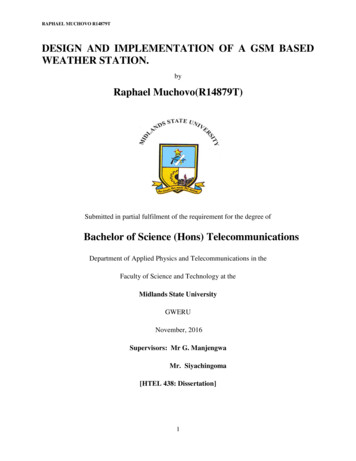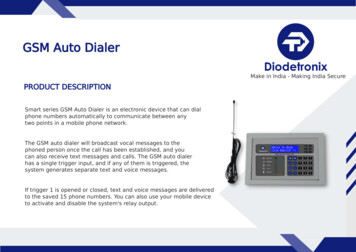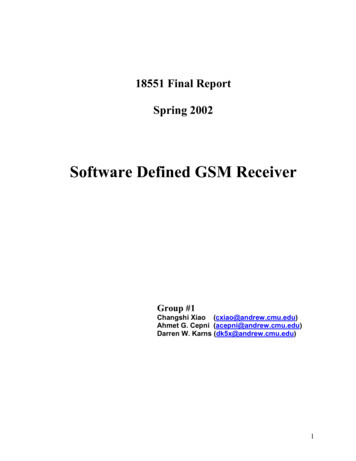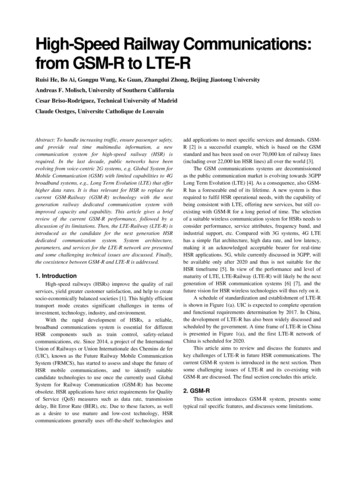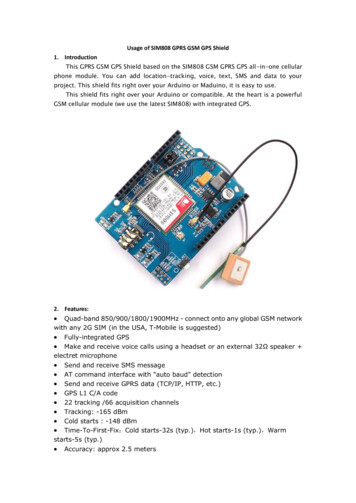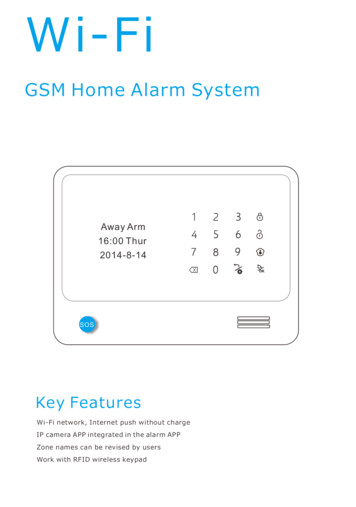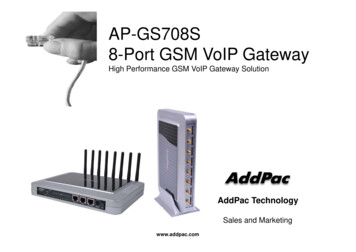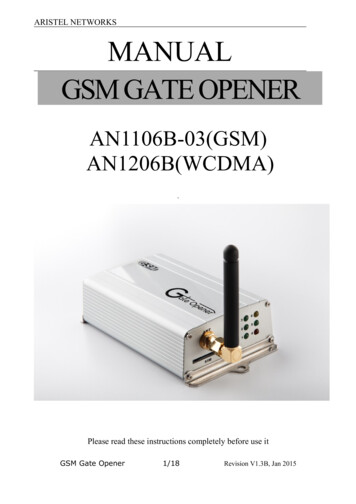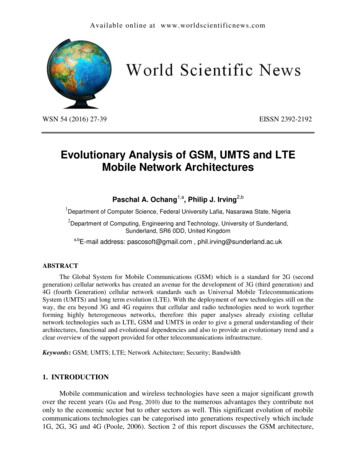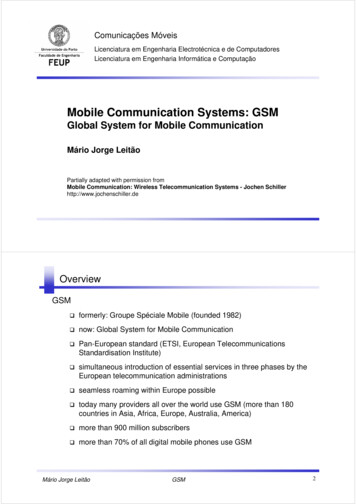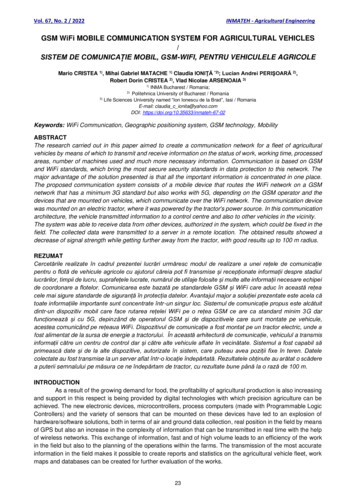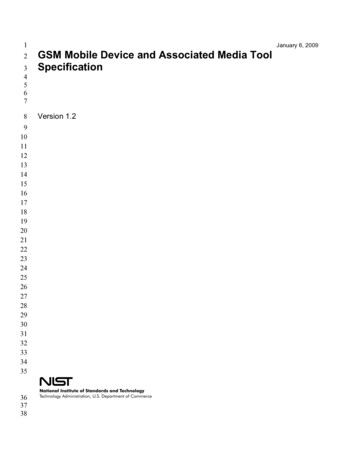
Transcription
03132333435363738January 6, 2009GSM Mobile Device and Associated Media ToolSpecificationVersion 1.2
39404142434445464748495051AbstractAs mobile devices proliferate, incorporating a host of integrated features and capabilities, their usecan be seen everywhere in our world today. Mobile communication devices contain a wealth ofsensitive and non-sensitive information. In the investigative community their use is not restricted todata recovery alone as in criminal cases, but also civil disputes and proceedings, and their aggregateuse in research and criminal incident recreation continues to increase. Due to the exploding rate ofgrowth in the production of new mobile devices appearing on the market each year is reason aloneto pay attention to test measurement means and methods. The methods a tool uses to capture,process, and report data must incorporate a broad range of extensive capabilities to meet thedemand as a robust data acquisition tool. In general, a forensic examination conducted on a mobiledevice is only a small subset of the larger field of digital forensics. Consequentially, toolspossessing an exhaustive array of capabilities to acquire data from these portable mobile devices arerelatively few in number.525354555657585960616263This paper defines requirements for mobile device applications capable of acquiring data frommobile devices operating over a Global System for Mobile communication (GSM) network and testmethods used to determine whether a specific tool meets the requirements, and assertions derivedfrom requirements producing measurable results. Test requirements are statements used to derivetest cases that define expectations of a tool or application. Test cases describe the combination oftest parameters required to test each assertion. Test assertions are described as general statements orconditions that can be checked after a test is executed. Each assertion appears in one or more testcases consisting of a test protocol and the expected test results. The test protocol specifies detailedprocedures for setting up the test, executing the test, and measuring the test results. The associatedassertions and test cases are defined in the test plan document entitled: GSM Mobile Device andAssociated Media Tool Test Assertions and Test Plan.646566Your comments and feedback are welcome; revisions of this document are available for downloadat: http://www.cftt.nist.gov/mobile devices.htm.NIST does not endorse nor recommend products or trade names identified in this paper. All products used in this paperare mentioned for use in research and testing by NIST. ii
TABLE OF 8889901.2.3.4.5.6.7.8.9.Introduction .1Purpose .1Scope .2Glossary.2Handset Characteristics - Internal Memory .3SIM Characteristics .4Digital Evidence .4Test Methodology .5Requirements.59.1 Requirements for Core Features.59.2 Requirements for Optional Features .69.2.1 Presentation .69.2.2 Protection .79.2.3 Physical Acquisition.79.2.4 Access Card Creation .79.2.5 Log Files.79.2.6 Foreign Language.89.2.7 PIN Attempts.89.2.8 PUK Attempts .89.2.9 Stand-alone Acquisition .89.2.10 Hashing.8iii
1261271281291301311322.IntroductionThe need to ensure the reliability of mobile device forensic tools intensifies, as the embeddedintelligence and ever-increasing storage capabilities of mobile devices expand. The goal of theComputer Forensic Tool Testing (CFTT) project at the National Institute of Standards andTechnology (NIST) is to establish a methodology for testing computer forensic software tools. Thisis accomplished by the development of both specific and common rules that govern toolspecifications. We adhere to a disciplined testing procedure, established test criteria, test sets, andtest hardware requirements, that result in providing necessary feedback information to toolmakersso they can improve their tool’s effectiveness; end users benefit in that they gain vital informationmaking them more informed about choices for acquiring and using computer forensic tools, andlastly, we impart knowledge to interested parties by increasing their understanding of a specifictool’s capability. Our approach for testing computer forensic tools is based on established wellrecognized international methodologies for conformance testing and quality testing. For moreinformation on mobile device forensic methodology please visit us at: http://www.cftt.nist.gov/.The Computer Forensic Tool Testing (CFTT) program is a joint project of the National Institute ofJustice (NIJ), the research and development organization of the U.S. Department of Justice, and theNational Institute of Standards and Technology’s (NIST’s) Office of Law Enforcement Standards(OLES) and Information Technology Laboratory (ITL). CFTT is supported by other organizations,including the Federal Bureau of Investigation, the U.S. Department of Defense Cyber Crime Center,U.S. Internal Revenue Service Criminal Investigation Division Electronic Crimes Program, U.S.Department of Homeland Security’s Bureau of Immigration and Customs Enforcement, U.S.Customs and Border Protection, and the U.S. Secret Service. The objective of the CFTT program isto provide measurable assurance to practitioners, researchers, and other applicable users that thetools used in computer forensics investigations provide accurate results. Accomplishing thisrequires the development of specifications and test methods for computer forensics tools andsubsequent testing of specific tools against those specifications.The central requirement for a sound forensic examination of digital evidence is that the originalevidence must not be modified (i.e., the examination or capture of digital data from a mobile deviceand associated media must be performed without altering the device or media content). In the eventthat data acquisition is not possible using current technology to access information withoutconfiguration changes to the device (e.g., loading a driver), the procedure must be documented.PurposeThis document defines requirements for mobile device forensic tools used in digital forensicscapable of acquiring internal memory from Global System for Mobile communication (GSM)devices and related media (i.e., Subscriber Identity Module [SIM]) and test methods used todetermine whether a specific tool meets the requirements.The requirements that will be tested are used to derive assertions. The assertions are described asgeneral statements of conditions that can be checked after a test is executed. Each assertiongenerates one or more test cases consisting of a test protocol and the expected test results. The test
133134135protocol specifies detailed procedures for setting up the test, executing the test, and measuring thetest results.1361371381393.ScopeThe scope of this specification is limited to software tools capable of acquiring GSM devices andrelated media (i.e., SIM). The specifications are general and capable of being adapted to other typesof mobile device forensic ciated data: Multi-media data (i.e., graphic, audio, video) that are attachedand delivered via a multi-messaging service (MMS) message.149150Acquisition File: A snapshot of data contained within the internal memory of a target device orassociated media (i.e. SIM).151152153Case File: A file generated by a forensic tool that contains the data acquired from a mobile deviceor associated media and case-related information (e.g., case number, property/evidencenumber, agency, examiner name, contact information, etc.) provided by the examiner.154155Cellular phone: A device whose major function is primarily handlingincoming/outgoing phone calls with limited task management applications.156CFT: Cellular Forensic Tool.157158Enhanced Message Service (EMS): Text messages over 160 characters ormessages that contain either Unicode characters or a 16x16, 32x32 black and white image.159Flash memory: Non-volatile memory that retains data after the power is removed.160161GSM: Global System for Mobile communications is an open, digital cellular technologyfor transmitting mobile voice and data services.162163Hashing: The mathematical algorithmic process of creating a numeric fingerprint value thatfacilitates uniqueness.164165Human-readable format: Acquired data (e.g., text, images) that is interpreted by the forensicapplication and presented in a human-readable format without decoding.166IM: Internal Memory.167168Logical acquisition: Implies a bit-by-bit copy of logical storage objects (e.g.,directories and files) that reside on a logical store (e.g., a file system partition).169170Mobile Subscriber International Subscriber Directory Number (MSISDN): The MSISDNconveys the telephone number assigned to the subscriber for receiving calls on the phone.This glossary was added to provide context in the absence of official definitions recognized by thecomputer forensics community.Access card/Radio isolation card: Subscriber Identity Modules (SIMs) that contain necessary dataelements allowing GSM equipment to operate without network connectivity.Page 2 of 9
171172Multimedia Messaging Service (MMS) message: Provides users with the abilityto send text messages containing multimedia objects (i.e., graphic, audio, video).173174Preview pane: Section of the Graphical User Interface (GUI) that provides a snapshot of theacquired data.175Physical acquisition: A bit-by-bit copy of the data layer.176177Personal Information Management (PIM) data: Data that contains personal information such as:calendar entries, to-do lists, memos, reminders, etc.178179180181Personal Identification Number (PIN): A numeric code used for preventing unauthorized accessto a device generally associated with the SIM. PIN1 is the primary means of access to ahandset. PIN2 when activated provides additional security for a small set of features (e.g.,resetting call meters, changing fixed dialing numbers).182183PIN UnlocK Code (PUK): A required code to unlock a disabled SIM due to three successiveincorrect PIN attempts. PUK1 and PUK2 are used to unblock PIN1 and PIN2 respectively.184185Short Message Service (SMS): A service used for sending text messages (up to 160 characters) tomobile devices.186187188Subscriber Identity Module (SIM): A smart card which contains essential subscriberinformation and additional data providing network connectivity to mobile equipmentoperating over a GSM network.189190191192Smart phone: A full-featured mobile phone that provides users with personalcomputer like functionality by incorporating PIM applications, enhanced Internetconnectivity and email operating over an Operating System supported by superiorprocessing and high capacity storage.193194Stand-alone data: Data (e.g., graphic, audio, video) that is not associated with or has not beentransferred to the device via email or MMS message.195User data: Data populated onto the device using applications provided by the device.1961971981992002012022032042052065.Handset Characteristics - Internal MemoryMobile devices, designed with the primary purpose of placing and receiving calls, maintain data inflash memory. Typically, the first part of flash memory is filled with the operating system and thesecond part is allocated for user data. Although information is stored in a proprietary format,forensic tools tailored for mobile device acquisition should minimally be able to perform a logicalacquisition for supported devices and provide a report of the data present in the internal memory.Tools that possess a low-level understanding of the proprietary data format for a specific devicemay provide examiners with the ability to perform a physical acquisition and generate reports in ameaningful (i.e., human-readable) format. Currently, the tools capable of performing a physicalacquisition on a mobile device are limited.207Page 3 of 9
2082092102112122132142152162172182192202212226.SIM CharacteristicsDue to the GSM 11.111 standard, mobile device forensic tools designed to extract data from a SIMvia an external reader should be able to properly acquire, decode, and present data in a humanreadable format. An abundance of information is stored on the SIM such as Abbreviated DialingNumbers (ADNs), Last Numbers Dialed (LND), Short Message Service (SMS) messages,subscriber information (i.e., IMSI), and location information (i.e., Location Information [LOCI],General Packet Radio Service Location [GPRSLOCI]). Tools optionally should provide support forUniversal Subscriber Identity Modules (USIMs), the third generation (3G) card which carries outthe same functions as its 2G cousin (i.e., SIM).Optionally, mobile device forensic tools should provide the ability to create an access SIM2 in theevent that the mobile equipment (ME) is found without the SIM present. Devices found without theSIM present may cause difficulty in acquiring the internal memory of the related device. Therefore,the ability to create an access card bypasses this problematic situation and allows for completion ofinternal memory 52362377.Digital EvidenceThe amount and richness of data contained on mobile devices is dependent upon device type (i.e.,low-end, high-end) and personal usage. However, there is a core set of data that computer forensictools can recover that remains somewhat consistent on all devices with cellular capabilities. GSMdevices provide two areas for data storage: device internal memory and the SIM. Tools should havethe ability to recover the following data elements stored in the device’s internal handset memory: International Mobile Equipment Identifier (IMEI)Personal Information Management (PIM) data – (e.g., Address book, Calendar entries, to-dolist, Tasks)Call logs – Incoming and outgoing callsText messages (SMS, EMS)Multi-media Messages (MMS)/email – and associated dataFile storage – Stand-alone files such as audio, graphic and video238239240241242243244245246247Tools shall have the ability to recover the following data elements stored on the SIM memory: Service Provider Name (SPN)Integrated Circuit Card Identifier (ICCID)International Mobile Subscriber Identity (IMSI)Mobile Subscriber International ISDN Number (MSISDN)Abbreviated Dialing Numbers (ADNs)Last Numbers Dialed (LND)Short Message Service (SMS) – text messages under 160 sm11-11.pdfAccess cards or radio isolation cards contain necessary fields that allow the ME to function without networkconnectivity.2Page 4 of 9
248249250 Enhanced Message Service (EMS) – text messages greater than 160 charactersLocation Information (LOCI)General Packet Radio Service (GPRS) location – 2652662672682692708.Test MethodologyTo provide concise test results of tools capabilities, the following test methodology will be strictlyfollowed. The forensic application under evaluation will be installed on a dedicated (i.e., no otherforensic applications are installed) host machine operating over the required platform as specifiedby the application. Two identical GSM devices will function as the source and target devices. Theinternal memory of the source and target devices will be populated with a pre-defined dataset aswill the source and target SIMs. Source, target devices and associated media (i.e., SIM), subsequentto initial data population, will be stored in a protected state eliminating the possibility of datamodification due to network connectivity. Each succeeding test entails recreating the hostenvironment for each specific tool tested and re-populating the target device and SIM. During theacquisition process, all data transmissions (sent and received data packets) between the device andapplication will be captured and logged via a port monitoring utility.The following data elements will be used for populating the internal memory of the cellular device:Address book, PIM data, call logs, text messages (SMS, EMS), MMS messages/email withattachments (i.e., images, audio, video) and stand-alone data files (i.e., audio, graphic, video). Thefollowing data elements will be used for populating the SIM: Abbreviated Dialing Numbers(ADNs), Last Numbers Dialed (LND), Short Messaging Service (SMS) messages marked as Read,Unread and Deleted, EMS messages, and location (LOCI) 2832842852862872889.1RequirementsThe requirements are in two sections: 9.1 and 9.2. Section 9.1 lists requirements (i.e., CellularForensic Tool-Internal Memory-01 [CFT-IM-01] through CFT-IM-05 and Cellular Forensic ToolSubscriber Identity Module-01 [CFT-SIM-01] through CFT-SIM-06) that all acquisition tools shallmeet. Section 9.2 lists requirements (i.e., Cellular Forensic Tool-Internal Memory Optional-01[CFT-IMO-01] through CFT-IMO-10 and Cellular Forensic Tool-Subscriber Identity ModuleOptional-01 [CFT-SIMO-01] through CFT-SIMO-10) that the tool shall meet on the condition thatspecified features or options are offered by the tool.Requirements for Core FeaturesThe following requirements are mandatory and shall be met by all mobile device forensic toolscapable of acquiring internal handset memory and SIM memory.Internal Memory Requirements:CFT-IM-01 A cellular forensic tool shall have the ability to recognize supported devices via thevendor supported interfaces (e.g., cable, Bluetooth, Infrared).CFT-IM-02 A cellular forensic tool shall have the ability to identify non-supported devices.Page 5 of 9
2303304305306307308SIM Requirements:CFT-SIM-01 A cellular forensic tool shall have the ability to recognize supported SIMs via thevendor supported interface (e.g., PC/SC reader, proprietary reader).CFT-SIM-02 A cellular forensic tool shall have the ability to identify non-supported SIMs.CFT-SIM-03 A cellular forensic tool shall have the ability to notify the user of connectivity errorsbetween the SIM reader and application during acquisition.CFT-SIM-04 A cellular forensic tool shall have the ability to provide the user with the opportunityto unlock a password protected SIM before acquisition.CFT-SIM-05 A cellular forensic tool shall have the ability to provide the user with either apreview pane or generated report view of data acquired.CFT-SIM-06 A cellular forensic tool shall have the ability to acquire all application supported dataelements present in the SIM memory without 20321322323324325CFT-IM-04CFT-IM-05A cellular forensic tool shall have the ability to notify the user of connectivity errorsbetween the device and application during acquisition.A cellular forensic tool shall have the ability to provide the user with either apreview pane or generated report view of data acquired.A cellular forensic tool shall have the ability to logically acquire all applicationsupported data elements present in internal memory without modification.Requirements for Optional FeaturesThe following requirements define optional tool features. If a tool provides the capability defined,the tool is tested as if the requirement were mandatory. If the tool does not provide the capabilitydefined, the requirement does not apply.The following optional features are identified: PresentationProtectionPhysical acquisitionAccess Card/Radio Isolation Card creationLog file creationForeign language character supportRemaining PIN attemptsRemaining PUK attemptsStand-alone acquisitionHashing3263273283299.2.1 Presentation330331CFT-IMO-01 A cellular forensic tool shall have the ability to provide a presentation of acquireddata in a human-readable format via a generated report.Requirements CFT-IMO-01 through CFT-IMO-02 apply to Optional Internal MemoryRequirements. Requirements CFT-SIMO-01 through CFT-SIMO-02 apply to Optional SIMRequirements.Page 6 of 9
332333334335336337338339CFT-IMO-02 A cellular forensic tool shall have the ability to provide a presentation of acquireddata in a human-readable format via a preview pane view.3403413429.2.2 Protection343344345346347348CFT-IMO-03 A cellular forensic tool shall have the ability to protect the overall case file andindividual data elements from modification.3493503519.2.3 Physical Acquisition352353354355356357358CFT-IMO-04 A cellular forensic tool shall have the ability to perform a physical acquisition of thedevice’s internal memory without modification for supported devices.3593609.2.4 Access Card Creation361362363CFT-IMO-05 A cellular forensic tool shall have the ability to create an access card followingmanufacturer suggested protocols.3643653669.2.5 Log Files367368369370371CFT-IMO-06 A cellular forensic tool shall have the ability to create user-accessible and readablelog files outlining the acquisition process.CFT-SIMO-01 A cellular forensic tool shall have the ability to provide a presentation of acquireddata in a human-readable format via a generated report.CFT-SIMO-02 A cellular forensic tool shall have the ability to provide a presentation of acquireddata in a human-readable format via a preview pane view.Requirement CFT-IMO-03 applies to Optional Internal Memory Requirements. Requirement CFTSIMO-03 applies to Optional SIM Requirements.CFT-SIMO-03 A cellular forensic tool shall have the ability to protect the overall case file andindividual data elements from modification.Requirement CFT-IMO-04 applies to Optional Internal Memory Requirements. Requirement CFTSIMO-04 applies to Optional SIM Requirements.CFT-SIMO-04 A cellular forensic tool shall have the ability to perform an acquisition ofthe data present on supported Subscriber Identity Modules (SIMs) withoutmodification.Requirement CFT-IMO-05 applies to Optional Internal Memory Requirements.Requirement CFT-IMO-06 applies to Optional Internal Memory Requirements. Requirement CFTSIMO-05 applies to Optional SIM Requirements.CFT-SIMO-05 A cellular forensic tool shall have the ability to create user-accessible and readablelog files outlining the acquisition process.Page 7 of 9
3723733749.2.6 Foreign Language375376377378379380381382383384CFT-IMO-07 A cellular forensic tool shall have the ability to present data objects containingforeign language character sets acquired from the internal memory of the device viathe suggested interface (i.e., preview pane, generated report). Non-ASCII charactersshall be printed in their native format (e.g., Unicode UTF-8).3853869.2.7 PIN Attempts387388389CFT-SIMO-07 A cellular forensic tool shall have the ability to present the remaining number ofCHV1/CHV2 PIN unlock attempts.3903919.2.8 PUK Attempts392393394CFT-SIMO-08 A cellular forensic tool shall have the ability to present the remaining number ofPUK unlock attempts.3953969.2.9 Stand-alone Acquisition397398399CFT-IMO-08 A cellular forensic tool shall have the ability to acquire internal memory data withoutmodifying data present on the SIM.4004014024039.2.10 Hashing404405406407408409410CFT-IMO-09 A cellular forensic tool shall have the ability to provide a hash for individual dataelements.CFT-IMO-10 A cellular forensic tool shall have the ability to provide a hash for the overall casefile.Requirement CFT-IMO-07 applies to Optional Internal Memory Requirements. Requirement CFTSIM-06 applies to Optional SIM Requirements.CFT-SIMO-06 A cellular forensic tool shall have the ability to present data objects containingforeign language character sets acquired from the SIM via the suggested interface(i.e., preview pane, generated report). Non-ASCII characters shall be printed in theirnative format (e.g., Unicode UTF-8).Requirement CFT-SIMO-07 applies to Optional SIM Requirements.Requirement CFT-SIMO-08 applies to Optional SIM Requirements.Requirement CFT-IMO-08 applies to Optional Internal Memory Requirements.Requirement CFT-IMO-09 through CFT-IMO-10 apply to Optional Internal MemoryRequirements. Requirement CFT-SIMO-09 through CFT-SIMO-10 apply to Optional SIMRequirements.CFT-SIMO-09 A cellular forensic tool shall have the ability to provide a hash for individual dataelements.Page 8 of 9
411412413414CFT-SIMO-10 A cellular forensic tool shall have the ability to provide a hash for the overall casefile.Page 9 of 9
50 possessing an exhaustive array of capabilities to acquire data from these portable mobile devices are 51 relatively few in number. 52 53 This paper defines requirements for mobile device applications capable of acquiring data from 54 mobile devices operating over a Global System for Mobile communication (GSM) network and test
